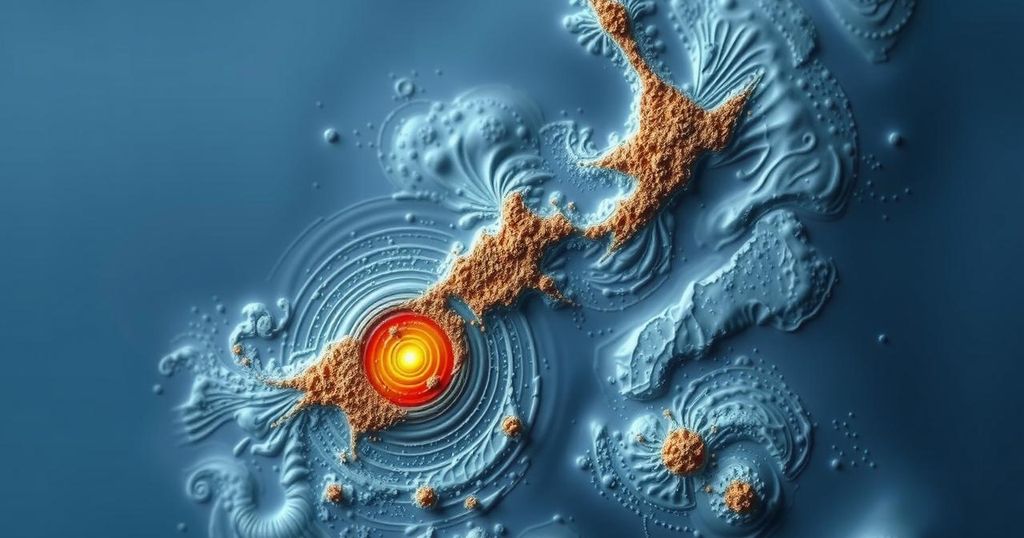Weather
ASIA, AUSTRALIAN, CLIMATE, EARTHQUAKES, EUROPE, GERMANY, HAWKE ’ S BAY, HIKURANGI, HIKURANGI SUBDUCTION ZONE, JAPAN, MAHIA, MAHIA PENINSULA, NEW ZEALAND, NONE, NORTH ISLAND, NORTHERN HAWKE ’ S BAY, OCEANIA, PACIFIC, RAIN, TECHNOLOGY, TOLAGA BAY, U. S, WAIROA, WEATHER FORECAST
Elena Martinez
0 Comments
Significant Slow-Slip Earthquake Event Near Hawke’s Bay, New Zealand
A slow-slip earthquake event has been recorded near Hawke’s Bay, New Zealand, along the Hikurangi Subduction Zone since early December. GNSS data indicates significant land displacements, suggesting rapid tectonic activity. This event has garnered international research interest with new instruments deployed for extensive monitoring and analysis of subduction processes. SSEs, while releasing energy gradually, also influence stress distribution and may trigger minor earthquakes in nearby regions.
A significant slow-slip earthquake (SSE) event has been taking place near Hawke’s Bay in New Zealand since early December, along the Hikurangi Subduction Zone. This tectonic boundary delineates the Australian and Pacific plates and is integral to the area’s geological structure. Notably, Global Navigation Satellite System (GNSS) stations in proximity to Mahia Peninsula have recorded substantial ground movements of approximately 4 cm eastward and 1 cm southward over the last three weeks of December.
Additional monitoring stations between Wairoa and Tolaga Bay exhibited similar displacements, with some sites reporting movements up to 8 cm. This activity indicates a remarkable acceleration in tectonic plate motion, equivalent to two years of natural shifts occurring within a mere three-week timeframe. The most recent SSE prior to the current event transpired in June 2023, evidencing the repetitive nature of these geological occurrences in the Northern Hawke’s Bay and Mahia regions.
International interest in the ongoing SSE has intensified, with over 50 offshore instruments deployed since 2014 to study the Hikurangi Subduction Zone. They include ocean-bottom seismometers and various pressure sensors designed to monitor tectonic movements accurately. Researchers from New Zealand, Germany, Japan, and the United States are collaborating to refine their understanding of subduction processes through these advanced tools.
In 2023, the drilling vessel JOIDES Resolution established two observatories located up to 500 meters beneath the ocean floor near the SSE site. These observatories aim to collect long-term data cycles about SSEs, while U.S.-funded projects recently installed seafloor flowmeters to track subsurface water movements relating to the slow-slip events. Data extracted from these instruments will provide deeper insights into the complexities of the subduction zone dynamics.
The Hikurangi Subduction Zone, recognized as New Zealand’s largest fault line, is characterized by the Pacific Plate’s annual movement of 2 to 6 cm. Although SSEs have been identified since 2002, the phenomenon represents a gradual release of stress that circumvents traditional seismic activity. Unfortunately, while SSEs might relieve stress in certain areas, they can inadvertently heighten stress in neighboring zones, resulting in the occurrence of smaller earthquakes, some of which have been recently documented near the Mahia Peninsula.
The ongoing slow-slip earthquake (SSE) event near Hawke’s Bay, New Zealand, highlights a notable aspect of tectonic activity in the region. The Hikurangi Subduction Zone is a crucial tectonic boundary involving the movement of the Australian and Pacific plates. It has been a subject of study for many years due to its intricate geological configuration. SSEs differ fundamentally from typical earthquakes; they involve a gradual release of tectonic stress, resulting in ground displacement without the ground shaking commonly experienced during regular seismic events. SSEs may alleviate stress in specific parts of the subduction zone but can also lead to increased stress in surrounding regions, possibly triggering minor earthquakes. As interest in such phenomena grows, comprehensive monitoring and research initiatives have been established to better understand their characteristics and implications for future tectonic behavior.
In summary, the slow-slip earthquake occurring near Hawke’s Bay, New Zealand, indicates significant tectonic activity within the Hikurangi Subduction Zone. This SSE event, characterized by a notable shift in land measurements, underscores the importance of continued geological research and monitoring to understand the complex dynamics of tectonic interactions. The collaborative international efforts to observe and analyze these phenomena aim to enhance the understanding of subduction processes and their impact on the region. Such studies ultimately contribute to effective preparedness for future seismic events and improve overall knowledge of tectonic processes.
Original Source: watchers.news




Post Comment